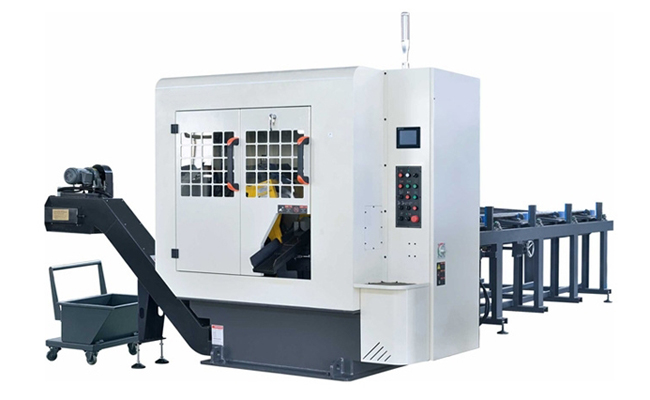TGK-4235 Double Column Band Saw
Cutting Capacity :
The application efficiency of circular saw machines is comprehensively influenced by multiple factors and mainly depends on the following aspects:

1. Equipment performance and configuration
The quality of saw blades: material (such as hard alloy, diamond coating), tooth profile design, sharpness and wear resistance directly affect the cutting speed and accuracy.
Machine tool power: The motor power should match the hardness of the material and the thickness of the cut. Insufficient power will lead to a decrease in efficiency.
Spindle speed and feed rate: A reasonable ratio of speed to feed can optimize cutting efficiency and prevent it from being too fast (increased wear) or too slow (wasted time).
Degree of automation: Numerical control (CNC) systems, automatic feeding devices and laser positioning can significantly enhance the accuracy and speed of continuous operations.
2. Material properties
Material hardness: When cutting high-hardness materials such as stainless steel and titanium alloy, the feed rate should be reduced or a dedicated saw blade should be used.
Cross-sectional dimensions: The greater the material thickness/diameter, the longer the required cutting time, and it may need to be processed in stages.
Fixing method: Unstable material clamping can easily lead to vibration, reducing the cutting quality and efficiency.
3. Process parameter optimization
Cutting parameters: Adjust the saw blade speed, feed rate and cutting depth (such as layer-by-layer cutting) according to the material.
Cooling and lubrication: Appropriate coolant (oil-cooled or water-based) can reduce frictional heat, extend the service life of the saw blade and prevent material deformation.
Sawing path planning: During batch processing, optimizing the cutting sequence can reduce idle travel time.
4. Operation and Maintenance
Operational skills: Skilled workers can quickly adjust parameters and handle abnormalities (such as material deviation and saw blade jamming).
Maintenance and care: Regularly clean sawdust, lubricate the guide rails, and calibrate the saw blade angles to prevent equipment aging from affecting efficiency.
The timing for replacing saw blades: Replace passivated saw blades in a timely manner to avoid increased energy consumption due to forced cutting.
5. Production Management
Task scheduling: Reasonably arrange batch orders to reduce material change and debugging time.
Auxiliary time: Use a rapid clamping device or a mechanical hand for loading and unloading to shorten the non-cutting time.
Energy consumption management: Optimize the start-stop strategy of equipment to reduce standby energy consumption.
6. Environment and Safety
Working environment: The temperature and dust control in the workshop (such as installing a vacuum system) affect the stability of the equipment.
Safety measures: Although protective devices (such as emergency stop buttons) may temporarily interrupt operations, in the long run, they can prevent downtime losses caused by accidents.
Suggestions for efficiency improvement
Technology upgrade: Introduce an intelligent monitoring system to provide real-time feedback on the wear and cutting status of the saw blade.
Standardized operations: Establish a cutting parameter database to reduce waste during trial cutting.
Preventive maintenance: Establish a maintenance plan and record the lifespan of key components.
By comprehensively optimizing the above factors, the efficiency of the circular saw machine tool can be significantly improved, while taking into account both processing quality and cost control.
Cutting Capacity :
Cutting Capacity :